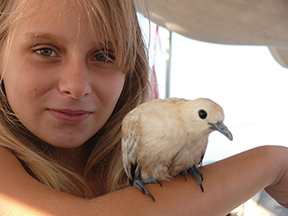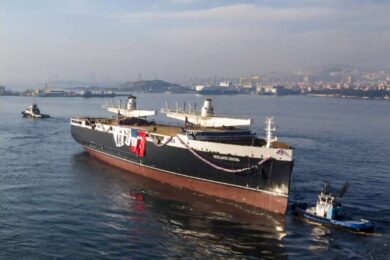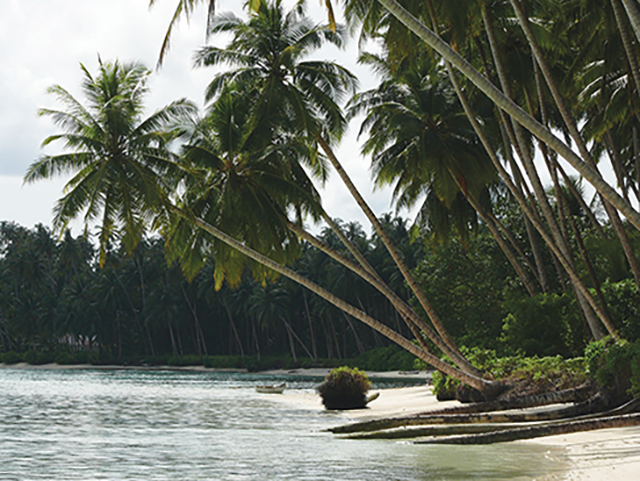The rewards of venturing off the beaten path (published January 2012)

The west coast of Sumatra remains somewhat of an enigma to those in the cruising world. Sailors venturing east from the African coastline may stop briefly on the northern tip of Aceh on Pualu Weh, but most continue directly onto Thailand or Malaysia. Others stay out to sea and disregard Indonesia altogether on their way to Australia. Northbound sailors on a pilgrimage through Indonesia tend to favor the sheltered waters on the eastern side of Java and Sumatra, the flat coastline, and the ship dodging sludge of the Malacca Strait.
Hence, West Sumatra is a relatively uncharted destination for private cruising boats. Charter boats servicing the lucrative surf business in the Mentawis and Nias dominate these islands, and during the surf season (April through October), the anchorages are highly populated. But if you are not a surfer, you need not compete for the anchorages close to the waves, and the array of uninhabited islands, palm-fringed beaches and tropical snorkeling opportunities is astounding. Indeed, between October and April, there is less southern swell and anchorages are abundant, nestling in the lee of the islands from the dominant northwest winds.
Situated close to the lip of the Indo-Australian plate, Sumatra has a shaky reputation. Literally. Earthquakes occur regularly, and the Great Tsunami of 2004 was generated off the western island of Simeulue. Consequently, Aceh, the northern state of Sumatra, was hurled into the world’s living rooms with images of its destruction and devastation. In Aceh alone, 170,000 people were killed; as the wave swept north, it took approximately 240,000 lives in total. World aid poured into the country, and the reality of Mother Nature’s wrath came to the forefront. Several months later, the Nias earthquake, measuring 8.6 on the Richter scale, killed 1,300 more and greatly altered the plates and reef structure of the islands. These natural occurrences further alienate Sumatra from the oft trodden tourist and cruising trail.
Evidence of the Tsunami and the Nias Earthquake is still apparent, not only in the physical altercation of the land, but in the odd-looking new villages that line the shore. In the eyes of the residents, there remains a fresh and hollow pain. Mark, who speaks Bahasa Indonesian, talked with a man on our boat whose pain was still so raw that he could not stop the tears from flowing. Various accounts of the wave were relayed, some saying 100 feet, others 60 feet, and still others speaking of a surge of water as it retreated and then swept inland, claiming miles of terra firma along the way.
CHASING WAVES

In the surf season of 2010, on our 42-foot Sayer GLAYVA, our family set sail from Malaysia for Indonesian adventures. Choosing to travel to Sumatra with our two children, Namara, age 10, and Arran, age 11, was of no obstruction to us, but many of our friends were concerned about future tsunamis, earthquakes, malaria, pirates and guerillas. My husband Mark and I have a deep respect and affection for Indonesia, and have traveled throughout this archipelago for over 20 years. Indeed, malaria is a concern, and suitable precautions need to be taken. But exploring Indonesia has taught us to be open and flexible, and we have never had an issue there. Mark had visited Sumatra on several occasions prior and remains an ardent surfer. Now with Arran following in his wake, the boys were eager to find some waves.
Our passage across the Malacca Strait was relatively uneventful, despite dodging the fishing nets, trawling boats and gigantic cargo ships rumbling to and from Singapore. Winds were light and we motor-sailed the 240 nm passage. Clearance is a simple process on the island of Pualu Weh on the northern tip of Aceh. A cruising permit, also known as a C.A.I.T., is required to navigate through Indonesia. Each boat can cruise in Indonesia for three months, and it is possible to renew your C.A.I.T through your provider for a further three months. Your C.A.I.T. provider can also provide a sponsorship letter, with which you will be capable of obtaining a two-month social visa from your nearest Indonesian Embassy. This too can be renewed while in the country.

Categorically an Islamic population, the Achenese and Sumatran people remain rigid in their practice, and care needs to be taken with regards to dress. Additionally, from Pualu Weh to Sibolga, you will not be able to buy any form of alcohol, the consumption of which also needs to be treated delicately. When you show respect, it will be returned to you. Banda Aceh, Sibolga, and Padang provide the best opportunities to stock your boat, but all along the coast, fresh fruits and vegetables, eggs and local food are in abundance. Water should be bought from the shop, as local drinking water is not safe for consumption. Any special “western treats” need to be brought with you, and dairy is virtually impossible to find. Both of my children adapted well to local standards and never complained about eating melons and mangoes on a daily basis. As an aside, it is never problematic to buy fuel, be it diesel or petrol, but it is recommended to use a fuel filter when filling up your tanks.
FOR THE BIRDS
Due to the arrival of Mark’s parents, who were flying into Padang to spend some time aboard, we had a fairly tight southbound schedule. Even with the time crunch, Arran befriended many fishing boys and village children, who often spent time with us on the boat. In the Tello islands, we became friends with Rinus and Suzi, who had three children. On one visit, Rinus thanked us with a very special gift—a dove, hand-reared and approximately eight weeks old, which we named Putih, meaning “white” in Bahasa Indonesian. This was indeed a delicate diplomatic moment, as we love animals, but have chosen not to have them on board; furthermore, neither of us likes the idea of birds in cages. But Putih had already lost his sense of self-survival skills and did not yet know how to fly.

The children were beyond excited when we accepted Putih into our family. A new cage was built and flying lessons were planned. Initially, the head was converted into an aviary, but after a week, Putih sat on our shoulders in the cockpit. We started taking him out in the dinghy to fly back to the boat. Our short-term goal was to allow Putih to learn to fly, then find an island with other doves where he could settle in. We knew that the longer we kept him, the more dependent he would become.
After Mark’s parents joined us in Padang, we sailed further south to the island of Cubadek. An oasis of a resort is nestled on this otherwise uninhabited island, offering a welcome break from cruising life. Anchored in 50 feet of water in a 360˚ sheltered bay, we were greeted warmly by the owner Nanni and his wife. After five weeks of heavy sailing, the communal international dinners, cosmopolitan feel, and freedom to wear a bikini in public were novel, but welcome experiences. Nanni allowed us to fill our tanks with water, as their supply is potable. In addition, he offered to assist us with the hiring of a car to restock in local Padang, approximately two hours north. It was on the island of Cubadek, at the Paradiso Village Resort, where Putih finally flew to his freedom.

Our northbound journey was more relaxed, and we met up with several friends on Moon Walker and Endless Dream, who departed Mooloolaba with us in 2007. Our journey led us to discover not just the surf breaks, but the typical Indonesian misadventures that contribute to making Indonesia such a pleasure—never a dull moment! In comparison to other cruising grounds in Indonesia, the west coast of Sumatra offers a unique opportunity to own an island, to roam freely and to relax indulgently.
Due to her physical location, Sumatra will continue to be a lesser-sailed path. For this very reason, she will remain a destination of beauty, simplicity and challenge for those who share her allure with the locals. Fresh forming coral, crystal clear waters, pristine white beaches and warm locals are but several reasons to choose Sumatra. The realities and possibilities of Mother Nature will do little to deter us from returning again.
Rachel Robertson, her husband Mark and their two children have sailed from Mooloolaba, Australia through Indonesia, Malaysia and Thailand, then back to Aceh and Sumatra. Their vessel, GLAYVA, is a 42-foot Sayer Cruiser Racer, built by Mark, who is a boat builder. Rachel is an early childhood teacher and avid photographer.

















